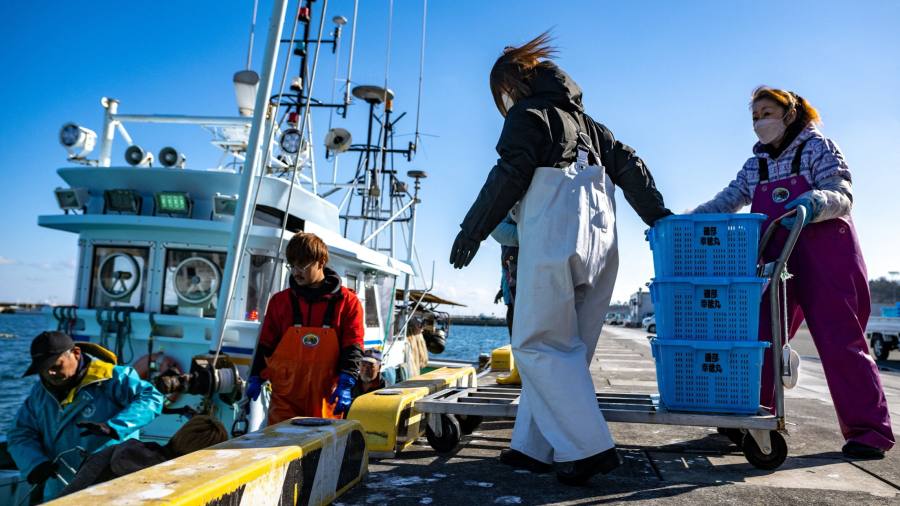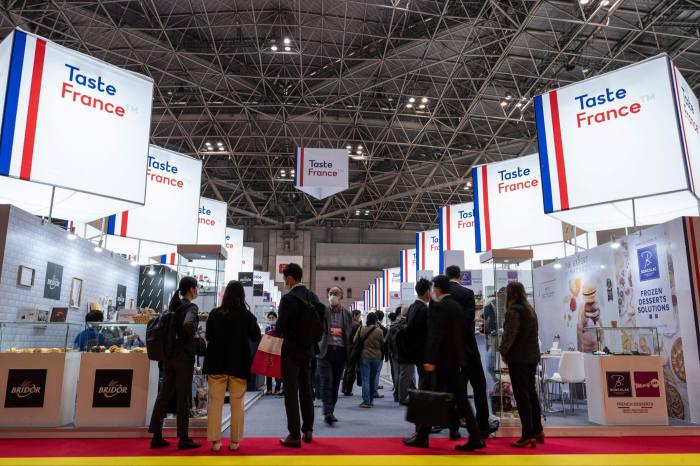
Receive free Food & Beverage updates
We’ll send you a myFT Daily Digest email rounding up the latest Food & Beverage news every morning.
For all of its exuberantly vast scale, and all its sumptuous products, and its fizzingly enthusiastic post-pandemic exhibitors, the Foodex 2023 trade show captured Japan at a vulnerable moment.
One exhibit in particular symbolised the issue: three plates of vegan sashimi. They appeared to be displaying delicious raw cuts of real tuna, salmon and squid. But — made purely from vegetable matter — these offerings may have represented the shape of menus to come, and the protection Japan needs against a fish sustainability crisis.
At one level, the Foodex in March was business as usual: producers of food from around the world enticed by the lucrative prospect of selling to cuisine-obsessed Japan. Historically, their efforts have paid off handsomely — Japanese agricultural imports stood at $70.2bn in 2022. However, while this year’s event, held in Tokyo, brought food producers back to a market increasingly dependent on imported calories, it was apparent that Japan is now more nervous about that level of dependency.

In 2021, Japan’s food self-sufficiency rate stood at 38 per cent — only marginally higher than the record low set in the previous year, and a far cry from the government’s target of 45 per cent self-sufficiency by 2030. And, since then, as the cost of imported ingredients — and even animal feed — has soared following Russia’s invasion of Ukraine, Japanese consumers’ sensitivity to high prices has only increased. The import model has been shown to be a food system for more predictable times.
Increasingly, though, the national concern about food self-sufficiency is being overlaid with intensifying debates around sustainability. In particular, says Yoshihiro Sugiura, director of sales at Azuma Foods, the country is becoming more anxious about predictions of worldwide protein shortages — especially of its favourite and most celebrated marine products. These fears are only exacerbated by UN estimates that the world’s human population will reach 9.7bn by 2050.
Fisheries products are seen as especially at risk. Since 1974, the UN’s Food and Agriculture Organization has tracked the ratio of global fish stocks that are at biologically sustainable levels. When the survey began, the ratio stood at 90 per cent. By 2019, it had dropped to just 64.6 per cent.
That collapse, says Sugiura, is of huge concern to a company such as Azuma, which began life as a traditional seafood trading company. “Global warming meant that the supply chain was unstable and we saw that it is not sustainable any more for ingredients, so we went to look for alternatives,” he says.
The company has begun experimenting with ways of making authentic looking — and, eventually, tasting — seafood that does not rely on the use of animal products.
In the early stages, he says, the focus will be on providing completely vegan and allergen-free sushi and sashimi-style products. The demand for that, he admits, is proportionally small, but could represent between 1-3 per cent of the raw fish market in Japan.
“In the long run, we know that a protein crisis is coming,” says Sugiura. “We know a shortage is coming and that is when the market could grow both domestically and overseas.”
The company is looking into alternative vegan materials to produce the always-popular crabsticks — a product that is already derived from pollock and other fish, rather than crab.
“Again, we look at global future supplies with a sense of crisis and how to achieve sustainability,” says Sugiura.
Azuma’s “Future Fish”, as it is labelled, is built around powdered konjac, a root vegetable, and its malleability into a substance with a texture surprisingly like raw fish — tuna, salmon and squid in the first instance, though other products are in the works. They include a plant-based version of the popular ikura salmon roe — another prized staple of Japanese cuisine.
The company has also begun shipping a vegan shrimp using starch and konjac moulded into an authentic-looking shape and has found a customer base among food manufacturers and restaurants experimenting with vegan salads and pizza.
From a distance, the company says, the products look quite realistic — although Sugiura admits the discerning diner can detect that it is not real.
The really difficult issue, though — and, for now, Azuma’s closely guarded secret — is recreating the taste. Konjac is notably bland and any addition of realistic seafood flavouring must necessarily avoid any animal-based ingredients. The Foodex show, says Sugiura, was a chance to get some frank feedback on the company’s efforts, ahead of the planned release of the fake fish on to supermarket shelves in Japan in July.
And Azuma is not alone in recognising the potentially huge demand for authentic alternative seafood. Even the Japanese giant Nippon Ham — a company that has been one of the nation’s foremost providers of animal products for years — has now entered the market for entirely non-meat alternatives. This year, the company introduced a product emulating fried fish but using soyabeans and seaweed extracts.